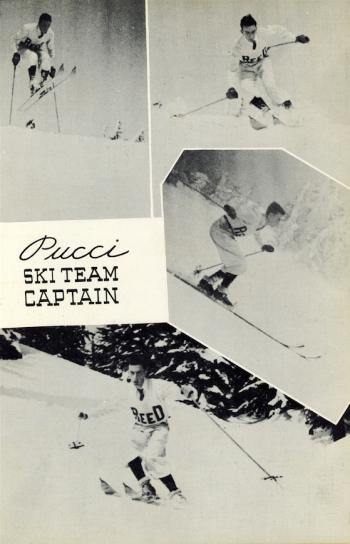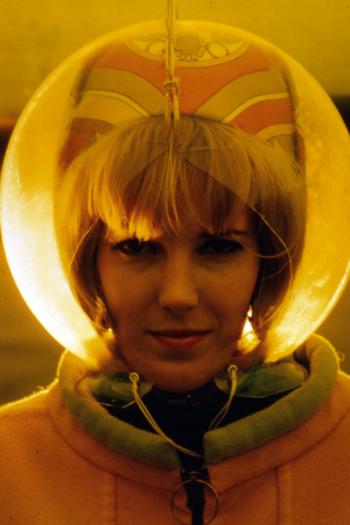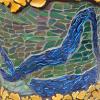Emilio Pucci in America
Celebrating the Prince of Prints' 100th Year

Braniff hostess wearing a pink Pucci uniform and bubble helmet standing in front of a Concorde airplane at the Paris Airshow, 1967. [Photo courtesy of Special Collections Department, Eugene McDermott Library, The University of Texas at Dallas.]
Nicknamed “The Prince of Prints,” Italian designer Emilio Pucci is best remembered for swirling, stream-of-consciousness patterns of brilliantly colored geometric shapes. Following a period marked by dull shades and heavy fabrics, his fun and flirty approach to design often clashed Mediterranean-inspired colors like turquoise, ultramarine and sea green against fuchsia, orange and lime. Widely emulated by other designers, his psychedelic palettes simultaneously channeled the spirit of the 1950s–70s and helped define the culture.
The fashion exhibition “Emilio Pucci in America,” currently on view at the Georgia Museum of Art, highlights the designer’s role in the rise of fashion following World War II. Through a selection of silk jersey dresses and other collaborations between Pucci and American manufacturers, the show illustrates how his time spent in the U.S.—which began with enrollment at UGA—inspired designs that revolutionized the world of fashion.

Emilio Pucci skiing at Reed College in the uniform he designed for the ski team there, 1937. [Photo courtesy of Special Collections, Eric V. Hauser Memorial Library, Reed College.]
Perhaps the antithesis of the rags-to-riches story, Marchese Emilio Pucci di Barsento was born in Naples in 1914 into an aristocratic family whose lineage dates back to 13th-Century Florence. The privilege and leisure time of his youth presented a rare opportunity to pursue a vast array of interests and hobbies, and though design was not initially among those, he became a master sportsman.
Following two years at the University of Milan, Pucci attended UGA to study agriculture, likely sent by his father to pick up knowledge that could be applied to the family’s Tuscan agribusiness interests. After a year in Athens, he transferred to Reed College in Portland, OR, where he received a scholarship in exchange for forming and coaching the school’s first ski team. Designing the team’s uniforms—his first foray into fashion—introduced him to mass production on a small scale and connected him to skiwear manufacturer White Stag, with which he continued to collaborate throughout his career.
Pucci returned to Italy in 1937 at the dawn of World War II and enlisted in the air force, eventually rising to the rank of captain. His moment of discovery as a designer came a decade later during a period of military leave, when his striking skiwear caught the eye of famed photographer Toni Frissell on the slopes of Zermatt, Switzerland. Frissell showed the images to Harper’s Baazar editor Diana Vreeland, who then commissioned Pucci to create a small collection to sell in the U.S., setting his career as a fashion designer into motion.

Photo courtesy of Braniff Airways Collection, History of Aviation Collection, Special Collections Department, Eugene McDermott Library, The University of Texas at Dallas.
Pucci’s upper-class status and financial independence gave him free reign over materializing his ideas, and he soon opened his first haute couture boutique on the Isle of Capri—home of the new Capri pants. Blending the casual comfort of sportswear with brightly colored, boldly patterned fabrics, his clothing reflected a lighthearted lifestyle of leisure and luxury that resonated with America’s desire for high-end yet ready-to-wear fashion. Pucci’s designs covered everything from handbags and accessories to lingerie and swimwear, and his printed silk dresses became immensely popular once jet-setters realized that their featherweight, wrinkle-free quality made them perfect for rolling into suitcases.

Photo courtesy of The University of Texas at Dallas.
Though he was Italian, many of Pucci’s accomplishments feel distinctly American, particularly his designs for Braniff International Airways and NASA. In 1965, Pucci created his first line of colorful, futuristic uniforms for the Braniff’s flight attendants, modeled at GMOA by a series of Barbie dolls. These avant-garde ensembles revolved around individual components—reversible coats, turtlenecks, crop jackets and culottes—that could be layered or removed in response to weather conditions, and even included a “bubble helmet” to protect hair from rain and the blast of jet engines. In 1971, David Scott and his fellow astronauts, exhausted from reviewing over 500 designs, invited Pucci to design the emblem for the Apollo XV lunar mission, extending his influence to the moon.
Associated events for “Emilio Pucci in America” include a tour led by independent curator Mary Koon on Wednesday, Dec. 3 at 2 p.m. and a holiday-themed Family Day on Saturday, Dec. 13 from 10 a.m.–12 p.m. in which children can create marbled ornaments inspired by the designer’s swirling patterns. “Get Your Pucci On,” an after-party for the museum’s biennial gala fundraiser, Elegant Salute, on Saturday, Jan. 31, will feature a fashion show organized by Agora Vintage with music by DJs Immuzikation and Z-Dog. The exhibition will remain on view through Sunday, Feb. 1.
Keywords
More by Jessica Smith
-

Art Around Town
A list of local art exhibits.
-

-

Art Around Town
A list of local art exhibits.









comments